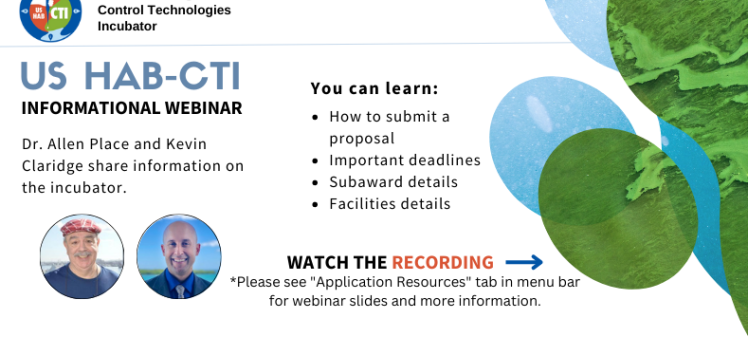United States Harmful Algal Bloom-Control Technologies Incubator
Want to receive news about future funding calls and information about US HAB-CTI? Email USHABCTI@umces.edu to be added to the listserv
About US HAB-CTI
*The term ‘harmful algal bloom’ means marine and freshwater algae that proliferate to concentrations that result in nuisance conditions or harmful impacts on marine and aquatic ecosystems, coastal communities, and human health through the production of toxic compounds or other biological, chemical, and physical impacts of the algae outbreak.*
The United States Harmful Algal Bloom-Control Technologies Incubator (US HAB-CTI) is a partnership between the National Oceanic and Atmospheric Administration (NOAA), University of Maryland Center for Environmental Science- Institute of Marine and Environmental Technology (IMET), and Mote Marine Laboratory (Mote). The goal of US HAB-CTI is to streamline the vetting process for novel HAB control ideas, allowing the research community and funding agencies to focus on efforts that promise to be feasible, environmentally acceptable, scalable, and cost-effective at controlling the impacts of both freshwater and marine blooms
HABs are a ubiquitous problem affecting coastal and Great Lakes waters around the United States. While significant advancements have been made in understanding the dynamics that lead to the formation and spread of HABs, effective methods for controlling and mitigating blooms at larger geographic scales remain elusive. The goal of the US HAB-CTI is to increase the number of available HAB control strategies that eliminate or reduce harmful algae and their toxins through biological, chemical, or physical means. This will be achieved through accelerating their development and assessment, as well as clarifying the licensing and permitting requirements for their application.
One of the objectives of the US HAB-CTI is to fund extramural proof of concept, innovative HAB control tools and technology projects to assess their real-world feasibility. As demonstrated in the image to the right, it is anticipated that US HAB-CTI research will largely be conducted as "Tier 1" in small scale lab testing and "Tier 2" in tanks, mesocosms, and raceways. Promising US HAB-CTI tools and technologies will be encouraged to apply to relevant future NOAA Prevention Control and Mitigation HAB competitive funding announcements or other opportunities independent from the US HAB-CTI (shown as "Tier 3" and "Tier 4" in below image).
A second objective of the US HAB-CTI is to develop a clearinghouse that offers guidance to end users and stakeholders on navigating the relevant licensing and permitting processes, as well as environmental compliance requirements for both potential and existing control technologies.
The US HAB-CTI is administered by an Executive Team composed of NOAA, IMET, and Mote. HAB management and research crosses many scientific disciplines and government responsibilities requiring various technical, scientific, and policy expertise – and control research often lacks efforts to synergize work, target proof of concept science/funding, and actively avoid duplicative processes/research. The US HAB-CTI receives guidance from an Advisory and Review Board with representatives from the Army Corps of Engineers, Environmental Protection Agency, US Geological Survey, NOAA, a state agency, an academic institution, a non-governmental institution, and a related industry.

Check out this informational webinar to learn more about US HAB-CTI and the proposal process. Please see the "Application Resources" tab in the menu bar for webinar slides and more information.